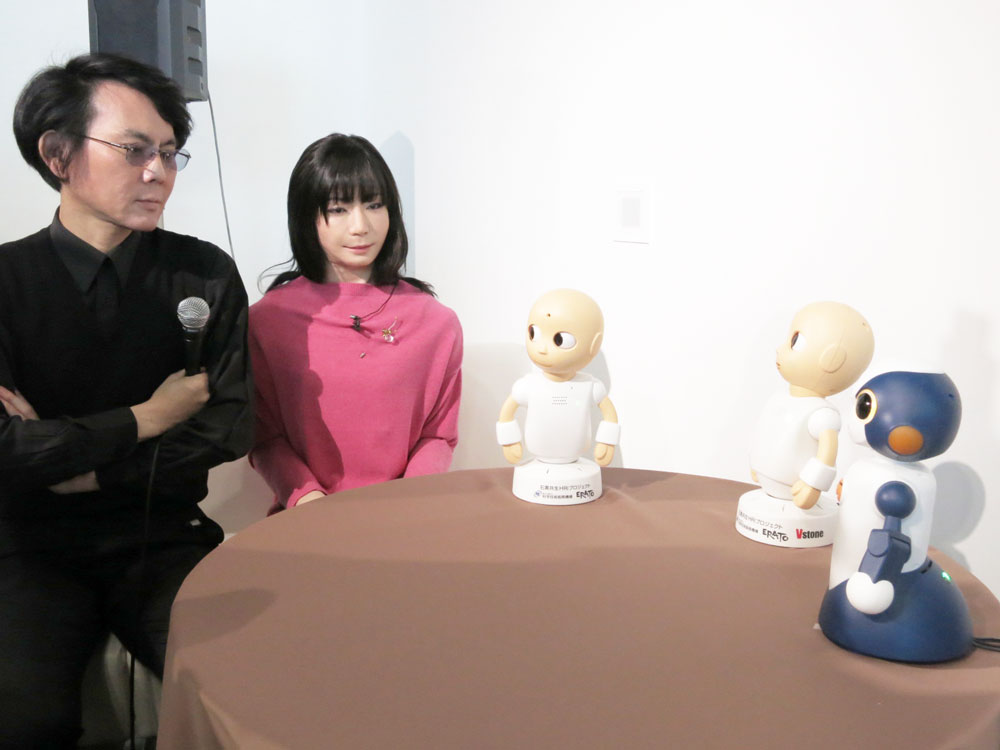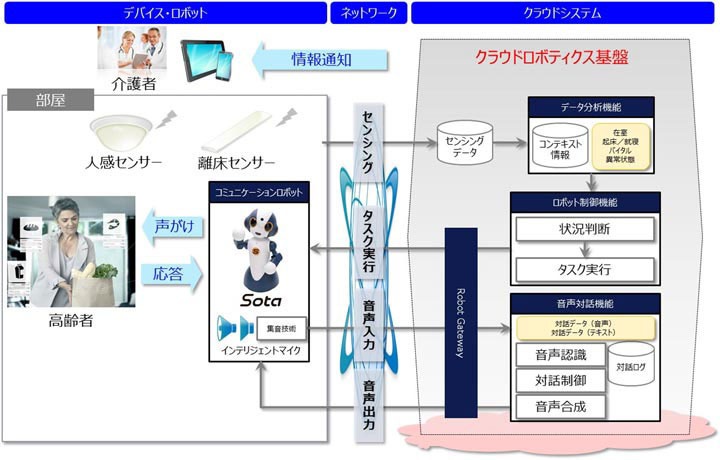
Robohub.org
Japanese telcos vie for share in consumer robot-as-a-service business
Yesterday a second Japanese telecommunication firm entered the consumer robot-as-a-service market when the state-owned Nippon Telegraph and Telephone Corporation (NTT) announced it would partner with its subsidiary NTT Data and robot maker Vstone to develop a tabletop companion robot that can talk and communicate with smart devices. NTT joins Softbank in the move to market networking and cloud computing services to a massive existing consumer base using consumer robotics. NTT says its Sota companion robot will cost about 100,000 JPY (~$800USD), with a monthly service fee of a few thousand JPY (~$30). UPDATE: Softbank will take pre-orders for enterprise version of Pepper starting Oct 1
Japan telco NTT jumps into consumer robot market with tabletop companion Sota.NTT seems to be betting that a simpler, smaller and less expensive device will be more appealing to Japanese consumers than Softbank’s larger (and mobile) Pepper, which costs about $1600 for the robot, plus $200 per month for the online service and maintenance contract. Japan, with its high housing costs, is notorious for its small apartments, and a table top robot that doesn’t need to navigate stairs or take up precious real estate might be just the competitive advantage NTT needs. Sota weighs about 1kg and is only 11″ (28cm) high.

Hiroshi Ishigura announces Sota at a press conference in January 2105. Source: Japan Times.
It remains to be seen how the two devices will compare in terms of their conversational abilities. In January of this year, Japanese robotics researcher Hiroshi Ishiguro – known for his work on extremely life-like humanoid robots – announced at a news conference that he was developing Sota (which stands for ‘social talker’) in collaboration with Vstone. At the news conference Ishiguro said that Sota’s conversational system was programmed to talk primarily with other robots, and not humans. “Voice recognition has always been very difficult for robots … Human beings should instead adjust to what robots can do.” In the video below, you can watch Sota interacting with CommU, another of Ishiguro’s robots that was unveiled at the same time. According to a story in the Japan Times, CommU and Sota “cannot understand what people are saying and are just acting out programmed conversations.”
This might suggest that Sota’s conversational abilities would be on the vacuous side, but this statement was presumably made before NTT and NTT Data entered the picture. One would expect NTT Data will bring its expertise in voice recognition and speech synthesis technologies to bear on the problem. NTT Data says it will develop apps for Sota, and deliver these via its parent company’s cloud networking services.

Sota’s conversational system. Source: NTT Data
NTT says Sota will be deployed in seniors’ homes as early as next March, and can be connected to medical devices to help monitor health conditions. This plays well with Japanese policy to develop and promote technological solutions to its aging population crisis.
It will be interesting to watch these two companies battle it out. Like Softbank, NTT is a Japanese telco providing phone, mobile, internet and network/technology services throughout Japan, but NTT has been around far longer, since 1952. According to Bloomberg, NTT’s 2014 earnings (10.9 trillion JPY) handily outstripped Softbank’s (6.7 trillion JPY), and the company ranks as one of the largest telcos in terms of revenue worldwide. While NTT is publicly traded, the Japanese government owns about one third of NTT’s shares. Sota is not NTT’s first foray into conversational robotics. Their subsidiary, NTT DoCoMo, have developed OHaNAS (video below) and Shabette.
Softbank, on the other hand, is somewhat smaller, but perhaps more agile. It has grown very quickly since its launch in 1981, and has made some astute moves in its short history, including partnering with Apple in 2008 to be the only official carrier of the iPhone in Japan (at least until the release of iPhone 4S). Softbank is also widely recognized in Japan for its forward thinking, creative and extremely popular marketing campaigns. While Softbank’s first big customer is Nestle (which is deploying Pepper as a customer service robot in its Nescafe stores this year), it’s clear from their recent promotional video (below) that they are still hoping to get a significant piece of the consumer pie by marketing Pepper’s abilities to recognize and appropriately respond to human emotions.
https://youtu.be/3a4sZnLRvqk
Sota is joining a number of tabletop companions, including Jibo and Amazon Echo, in the race to market. Where Sota stands apart, though, is in its backing from a major telco (Pepper has this, too, but is not a tabletop device). In this sense Sota becomes not so different from a cellphone or tablet with voice recognition – it’s simply a marketing vehicle through which data services are sold. With a major telco and its existing customer base onside, Sota could be poised to grab a significant slice of the companion robotics pie.
On the other hand, consumers might be wary of “yet another” talking device if it fails to provide real social benefits over other technology forms, like cellphones and tablets. While Cory Kidd (Catalia Health) has shown through evidence-based research that social robots can offer measurable benefits over software alone, the ability to supply meaningful companionship or effect health benefits through behaviour change will surely depend on the sophistication of the conversational system. As Andra Keay of Silicon Valley Robotics puts it: “Social robotics right now is like the early days of the mobile phone industry. When many companies brought handsets to market that basically all provided the same core functionality. However, some models of phone became phenomenally popular and others sank like stones. It remains to be seen where Sota fits in the new social device spectrum.”
If you liked this article, you may also be interested in:
- Forget Google and unicorns, Asian dragons are going to dominate robotics
- Foxconn and Alibaba invest in SoftBank Robotics as Pepper goes on sale in Japan
- Nestlé 1st big buyer of Softbank’s Pepper robot
- Natural language: The de-facto interface convention for social robotics
- The second wave of social robots is here
See all the latest robotics news on Robohub, or sign up for our weekly newsletter.
tags: c-Consumer-Household, cx-Business-Finance, Japan, NTT, Pepper, robohub focus on big deals, SoftBank


